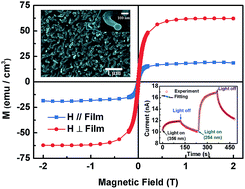Magnetic anisotropy and deep ultraviolet photoresponse characteristics in Ga2O3:Cr vermicular nanowire thin film nanostructure
Abstract
Nanostructures of magnetic doping semiconductors have attracted considerable attention due to their fantastic electronic, optical and magnetic properties as well as their unique morphology for both interconnects and functional units in fabrication of nanodevices. Herein, a Ga2O3:Cr vermicular nanowire thin film nanostructure was obtained on α-Al2O3 (0001) substrates by pulsed laser deposition. The nanostructure exhibits room temperature anisotropic ferromagnetic behavior with an easy axis perpendicular to the film plane and a Curie temperature of higher than 400 K. An obvious deep ultraviolet photoelectric response was obtained in the formed nanostructure.


 Please wait while we load your content...
Please wait while we load your content...